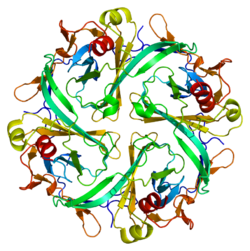Kir2.1
Kir2.1 내향성 칼륨 통로는 KCNJ2 유전자에 의해 암호화된 지질 게이트 통로(lipid-gated ion channel)이다.[5][6][7][8]
임상적 의의
[편집]이 유전자의 결함은 안데르센-타윌 증후군과 관련이 있다.[9]
KCNJ2 유전자의 돌연변이는 짧은 QT 증후군을 일으키는 것으로 나타났다.[10]
연구 중
[편집]신경유전학에서 Kir2.1은 Drosophila 연구에서 뉴런을 억제하는 데 사용된다.
광유전학에서, Kir2.1의 트래피킹 서열은 막 위치를 개선하기 위해 할로로돕신에 추가되었다. 생성 된 단백질 eNpHR3.0은 빛으로 뉴런을 억제하기 위해 광유전 연구에 사용된다.[11]
인간 HEK 293 세포에서 Kir2.1 유전자의 발현은 일시적인 외부 전류를 유도하여 칼륨의 반전 전위에 가까운 일정한 막 전위를 생성한다.[12]
상호 작용
[편집]Kir2.1은 다음과 상호 작용하는 것으로 나타났다.
각주
[편집]- ↑ 가 나 다 GRCh38: Ensembl release 89: ENSG00000123700 - 앙상블, May 2017
- ↑ 가 나 다 GRCm38: Ensembl release 89: ENSMUSG00000041695 - 앙상블, May 2017
- ↑ “Human PubMed Reference:”. 《National Center for Biotechnology Information, U.S. National Library of Medicine》.
- ↑ “Mouse PubMed Reference:”. 《National Center for Biotechnology Information, U.S. National Library of Medicine》.
- ↑ Hansen, SB (May 2015). “Lipid agonism: The PIP2 paradigm of ligand-gated ion channels.”. 《Biochimica et Biophysica Acta (BBA) - Molecular and Cell Biology of Lipids》 1851 (5): 620–8. doi:10.1016/j.bbalip.2015.01.011. PMC 4540326. PMID 25633344.
- ↑ “Molecular cloning and expression of a human heart inward rectifier potassium channel”. 《NeuroReport》 5 (18): 2501–5. 1994. doi:10.1097/00001756-199412000-00024. PMID 7696590.
- ↑ “Genetic and functional linkage of Kir5.1 and Kir2.1 channel subunits”. 《FEBS Lett.》 491 (3): 305–11. 2001. doi:10.1016/S0014-5793(01)02202-5. PMID 11240146.
- ↑ “International Union of Pharmacology. LIV. Nomenclature and molecular relationships of inwardly rectifying potassium channels”. 《Pharmacol. Rev.》 57 (4): 509–26. 2005. doi:10.1124/pr.57.4.11. PMID 16382105.
- ↑ “Andersen-Tawil syndrome: a model of clinical variability, pleiotropy, and genetic heterogeneity”. 《Ann. Med.》. 36 Suppl 1: 92–7. 2004. doi:10.1080/17431380410032490. PMID 15176430.
- ↑ “A novel form of short QT syndrome (SQT3) is caused by a mutation in the KCNJ2 gene”. 《Circ. Res.》 96 (7): 800–7. April 2005. doi:10.1161/01.RES.0000162101.76263.8c. PMID 15761194.
- ↑ “Molecular and cellular approaches for diversifying and extending optogenetics”. 《Cell》 141 (1): 154–65. April 2010. doi:10.1016/j.cell.2010.02.037. PMC 4160532. PMID 20303157.
- ↑ Zhang, De-Yong; Lau, Chu-Pak; Li, Gui-Rong (2009년 4월 1일). “Human Kir2.1 channel carries a transient outward potassium current with inward rectification”. 《Pflügers Archiv: European Journal of Physiology》 457 (6): 1275–1285. doi:10.1007/s00424-008-0608-0. ISSN 1432-2013. PMID 19002489.
- ↑ “Neuronal inwardly rectifying K(+) channels differentially couple to PDZ proteins of the PSD-95/SAP90 family”. 《J. Neurosci.》 20 (1): 156–62. 2000. doi:10.1523/JNEUROSCI.20-01-00156.2000. PMC 6774109. PMID 10627592.
- ↑ “Neuronal interleukin-16 (NIL-16): a dual function PDZ domain protein”. 《J. Neurosci.》 19 (18): 7770–80. 1999. doi:10.1523/JNEUROSCI.19-18-07770.1999. PMC 6782450. PMID 10479680.
- ↑ “Identification of gamma-aminobutyric acid receptor-interacting factor 1 (TRAK2) as a trafficking factor for the K+ channel Kir2.1”. 《J. Biol. Chem.》 281 (40): 30104–11. 2006. doi:10.1074/jbc.M602439200. PMID 16895905.





